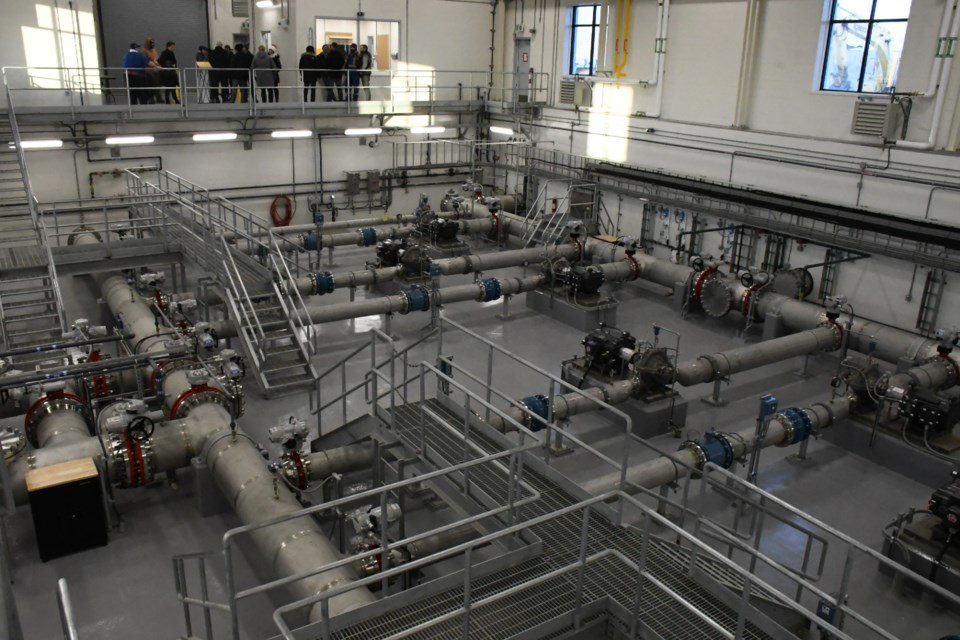The new high-service reservoir pumphouse may not affect water quality, but it will protect the community’s drinking water for another 50 years and enable the population to reach almost 50,000 people.
Dozens of dignitaries, politicians, city staff and contractors gathered at the new pumphouse on Dec. 20 for its official opening. The new brown-coloured brick pumphouse — adjacent to the original, 60-year-old structure — is behind the Lynbrook Golf Course and noticeable when driving north on Main Street.
A giant moose medallion on the building’s east side — made of Tyndall stone — looks similar to the medallions on the Thunderbird Viaduct bridge.
The city started construction of the $15-million building in September 2020 — contractors moved 2,760 square metres (92,000 cubic feet) of dirt — while the pumphouse began forcing water in August and commissioning finished this month — although final completions will occur in January.
The City of Moose Jaw invested $11 million, while the provincial government gave $3,936,996 through the Municipal Economic Enhancement Program (MEEP).
This venue is one of three reservoirs/pumphouses — the others are in the northeast and on South Hill — that distributes potable water to residents via a 20-kilometre transmission line that connects to the Buffalo Pound Water Treatment Plant (BPWTP).
The high-service reservoir pumphouse — 792 square metres (8,800 square feet) in size — supplies potable water to more than 60 per cent of the community and is designed to meet future population growth of 45,000.
The hum of the pumps and equipment filled the building during the ceremony, a hum that Mayor Clive Tolley said was also evident throughout the community as the city continued to grow.
“I’m very pleased with the fact we’ve had a pumphouse in this location for over 50 years and we expect that this location … will last another 50 years, so that’s exciting,” he continued. “That means water security for Moose Jaw and area for the next 50 years, and that’s very, very important to our community and our growth.”
The mayor thought the building was impressive and suited the community because of its heritage look. During a site tour, he saw all the brick and stonework and admired its quality. He thought the venue was something to appreciate.
City manager Jim Puffalt thanked all the project contractors and workers for their commitment before noting the building ensures the long-term stability of water security in Moose Jaw. It was the next project city hall pursued after completing the 20-kilometre transmission line to BPWTP in 2018.
The previous pumphouse was inadequate because employees could not access certain areas to shut off the water, which led to uncontrollable leaks, he continued.
“It’s really important that we took this project seriously and made efforts to replace the old pumphouse,” Puffalt said.
“… When we designed this building, we wanted to ensure it was very functional, but we also wanted to ensure it took into account the history of Moose Jaw and very much ties into the architectural features of the downtown.”
He added, “It’s a great day for Moose Jaw.”
Besides creating a functional building, it was great to add a nice aesthetic touch to the exterior of a vital piece of infrastructure and not just bury it in the ground, said Bevan Harlton, director of engineering. North of the pumphouse is the high-service reservoir with two cells that contain water from which to draw. Of the three pumphouses, this is the system’s main engine.
“The pumphouse … is phenomenal,” he continued, noting the venue can pull as little as 25 litres of water per second — similar to a farm pump — to as much as 660 litres per second if all six engines are running.
There are three engines on the west side of the room and three on the east side. Staff can shut down one side for maintenance while the other side can continue without interrupting flows to homeowners.
Harlton added that the BPWTP looks after water quality while the city pumps the water to residents’ homes.




